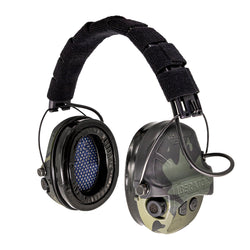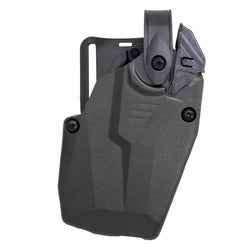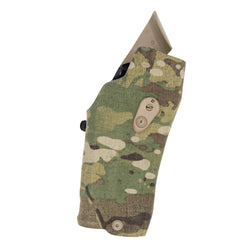When you shop for holsters, you’ll run into terms like IWB, OWB, AIWB, strongside, pocket carry, and so many more. It can be frustrating just to decipher the acronyms, and even once you do, you still need to figure out how exactly you will carry your gun. Before buying a holster, it’s essential to choose your carry position—without that, you’re shooting in the dark.

This guide will help you navigate holster positioning and find the best carry method for comfort and accessibility. We’ll cover both concealed carry and some duty carry considerations. Let’s start by looking at holster and carry positions as a whole.
Digging Into Carry Positions
This discussion focuses on modern carry positions for defensive firearm use. We won’t cover outdated methods like cross-draw or hunting-specific positions for big-bore revolvers.
Strongside OWB
The most common carry position places the gun outside the waistband on the user’s dominant side. OWB is a standard duty position and can be used for concealed carry. Several ride height options allow for a customized carry experience. For right-handed shooters, the gun sits between the two and five o’clock position on the belt.
OWB holsters are generally easy to draw from, and strongside OWB options are among the few that offer active retention. They’re also quite comfortable. The main drawback is that concealment can be challenging.

Strongside IWB
Like OWB, the strongside IWB position places the gun on the belt between two and five o’clock. However, the gun sits inside the waistband, pressed against the body, with most of it naturally concealed by your pants. This makes it a popular choice for concealed carry.
Strongside IWB offers a good balance of concealment and comfort but is generally slower to draw than some other carry methods.

AIWB
Appendix Inside-the-Waistband (AIWB) holsters are the fastest-growing segment in the holster market. This carry method positions the gun at the front of the body, enhancing both concealment and draw speed. As a result, AIWB is quickly becoming the dominant carry choice.
The main drawback is comfort — many users find it uncomfortable when sitting or driving for long periods.

Shoulder Holster
Shoulder holsters position the gun under your nondominant shoulder. This position isn’t as popular as it used to be, but it still has a cult following. Shoulder holsters require a light jacket or shirt for concealment.
Concealment tends to be its weakest point, and speed isn’t great either. Comfort isn’t bad, especially if you are driving a vehicle or isolated to a sitting position for long periods.

Pocket Carry
Pocket carry is exactly what it sounds like. Carry the gun in your front or back pocket, but ensure you are using a holster when you do so. Pocket guns can be very comfortable to carry, but you’re stuck with small guns.
Concealment is excellent, especially with a proper pocket holster. Access can be quick, but it becomes a serious challenge when sitting. One advantage is that pocket carry works with most forms of dress.

How To Find the Right Carry Position
To determine the best carry position for you, we need to answer a few key questions. This will help optimize concealment, access, and comfort. The right choice isn’t about just one factor — it’s about balancing them all.
Does Your Gun Match Your Carry Position?
Depending on your gun size, some carry options aren’t possible. Shoving a Glock 17 in your pocket won’t work well for concealment. On the flip side, finding a tactical duty holster for a KelTec P32 isn’t going to happen.
Before exploring different carry positions, apply some common sense to see if your gun is a good fit. While my examples are extreme, some cases are less obvious. The SIG P365 isn’t that big — so can you carry it in a pocket?
Maybe. A tool like Safariland’s Holster Finder can help by showing what holster options exist for your firearm, giving you a clearer idea of which carry positions are practical.

What’s Your Goal?
Are you looking to maximize concealment, achieve the fastest draw, or prioritize comfort? In the world of holsters, there’s always a bit of give and take. For example, if I want both speed and concealment, I’ll opt for an AIWB rig like the Incog X. If my priority is concealment and comfort, pocket carry might be the way to go. But if I value retention and speed over concealment, a strong-side OWB holster with an ALS or GLS device could be the best choice.
Identify your goals first, and use them as a guide when shopping for holsters. With the knowledge we’ve covered, we can now mix and match the pros and cons of different holster styles to align with your objectives.

How Do You Dress?
How you dress can also determine your holster and carry position. I transitioned from a traditional AIWB position to a pocket position after a recent promotion, which put me in a more formal daily wear situation. Tucked-in shirts, suit jackets, dresses, and more can make different carry positions difficult or impossible.
While T-shirts and jeans offer the most flexibility, that’s not always the case. You might still carry AIWB, but in a more formal setting, a tuckable option like the Incog X might be a better choice over a non-tuckable option like the Schema. Your style of dress may determine your carry position and holster type.

What’s Your Day Look Like?
Do you drive a lot? If so, pocket carry might be tough to access. Do you have a physical job that involves a lot of movement? You might need a more secure retention option. Maybe you sit at a desk all day—appendix carry might become uncomfortable after hours of wear, so a strongside IWB might work best.
Carefully examining your day will help you find the right holster, especially concerning comfort. Remember those shoulder holster carriers? They’re likely drivers. To choose the best option, we gotta weigh what your life looks like and consider how it impacts your carry method.

On Duty Carry positions
Duty carry options are often limited, especially due to agency regulations and requirements. Most duty holsters will be some form of retention-enabled strongside OWB holster. However, there are still key considerations to make, with the primary decision being ride height.
Low Ride
Low-ride positions the holster about 1.5 inches lower than the belt line. Professionals who wear plate carriers or outer gear vests often choose this method, as the lower height allows for easier clearance of the plate carrier and outer vest. It’s also one of the fastest positions to draw from since your hand naturally sits at the same position as your gun’s grip.
Some users find low-ride holsters less comfortable in vehicles. In my experience, it’s a very comfortable position to use inside a vehicle, but I’m larger than the average bear.

Mid Ride
Mid-ride is the traditional OWB carry position, sitting right at the belt line with the butt of the pistol even with the belt. This position is generally quite comfortable for patrol vehicles and everyday carry. However, it doesn’t work as well with outer carriers and plate carriers, as they can interfere with the gun when worn.
High Ride
High-ride, also known as detective carry, positions the butt of the gun higher than the belt. The position allows you to sit in a car or at a desk with total comfort. A slight forward cant is often used to make drawing quicker, which is often necessary due to a slower overall draw with this ride height.
Carry On
Finding the perfect carry position requires evaluating your firearm, setting your goals, and considering your typical attire and daily activities. This process will help create a clear, paint-by-numbers picture to help you find the best option for your needs, wants, and reality.









